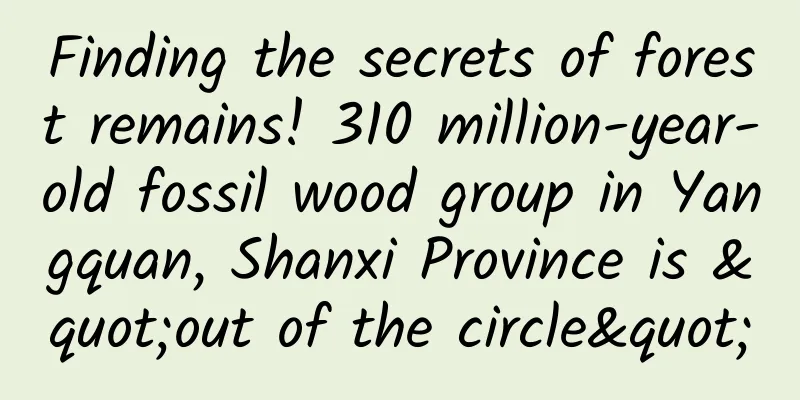Finding the secrets of forest remains! 310 million-year-old fossil wood group in Yangquan, Shanxi Province is "out of the circle"

|
Science and Technology Daily (Reporter Han Rong) On November 29, the reporter learned that the Nanjing Institute of Geology and Paleontology of the Chinese Academy of Sciences discovered a mineralized plant community dating back 310 million years ago in Yangquan City, Shanxi Province, which is also the remains of the oldest forest in North China . The relevant research papers were published in the international academic journals "Reviews in Paleobotany and Palynology" and "Ancient World". In October 2022, the Yangquan City Geological Disaster Prevention and Control Center discovered some wood fossils with good mineralization and clear wood structure in the first set of limestone interlayers above the suburban bauxite layer. This is the lowest and oldest wood fossil preserved in the rock strata in Yangquan City. Experts from the Nanjing Institute of Geology and Paleontology, Chinese Academy of Sciences, have conducted research on this. Since the 1930s, domestic and foreign experts have conducted a series of studies on the Late Carboniferous flora in North my country. Limited by the poor preservation of fossils and the lack of in-depth research, the systematic taxonomic research on the Late Carboniferous plants in my country stagnated at the beginning of this century. Researchers conducted anatomical research on more than 60 mineralized woods collected in Yangquan, and discovered for the first time the tree-type Cordaean plants of the Late Carboniferous period in my country, including Damudimu, Li's Kauri-type wood, and Uda's Kauri-type wood, as well as the early conifer (broadly defined) plant Paraiba wangii. Wang Keyu, a member of the Carboniferous-Permian plant research team of the Nanjing Institute of Geology and Paleontology, Chinese Academy of Sciences, introduced that according to the empirical formula of plant allometric growth, it was calculated that the Corda plants in the Cathaysian flora during the Late Carboniferous could grow to a height of 30 meters, correcting the erroneous view of European and American paleobotanists that there was no high-rise vegetation during the deposition period of the Benxi Formation in my country during the Late Carboniferous. Forest ecosystems are the main body of terrestrial ecosystems and have important ecological service functions. Wang Keyu said that this study also discovered the oldest "nursery wood" phenomenon to date. The "nursery wood" phenomenon refers to the stems or stumps of plants that provide nutrients and water for the germination of seeds and the growth of seedlings of other plants after death and decay, which can ensure the stability and sustainable development of forest communities . However, due to the lack of fossil evidence, the academic community does not know much about the origin and evolution of "nursery trees". In the wood fossils discovered this time, the researchers found that the stems of Cordae plants were interspersed with a large number of "small roots" of gymnosperms, indicating that the "nursery wood" phenomenon had appeared in the Chinese flora 310 million years ago. It is worth mentioning that the researchers also found a considerable number of beautifully preserved fungal fossils and a large number of fecal fossils in the wood fossils. Based on the analysis of the size, shape, surface structure and other characteristics of the fecal fossils, the researchers speculated that these feces were left behind by oribatid mites when they were feeding on wood. "Combining the previous research results with the latest findings of this study, in the early stages of the evolution of the Cathaysian flora, plant diversity, especially the diversity of gymnosperms, was much higher than we had previously known. The study of mineralized plants can to a large extent make up for the deficiency of the preservation of impression fossils being affected by the sedimentary environment." Wang Keyu said that this study shows that ecological phenomena such as plant-arthropod, plant-fungus, and plant-plant interactions were already very common in the Cathaysian plant geographical region during the Late Carboniferous, indicating that the terrestrial ecosystem structure at that time was already very complex. |
>>: From stinky tofu to spicy rabbit heads, how did these collections end up in museums?
Recommend
Waste becomes fuel, wood itself can't imagine
Forestry is an important support for the construc...
The efficacy and function of light board cat grass
Do you know what white cat grass is? If you know,...
Spending the Winter Solstice on Mars? It Did!
The northern hemisphere of Mars, where the Zhuron...
The efficacy and function of Qingfengteng
Recently, major TV channels have launched various...
This is the roundest object in the world, worth tens of millions, and its existence can change the world
Which object on Earth is closest to being a true ...
What are the contraindications of taking Chinese medicine for replenishing qi and blood?
I believe that one of the most troubling things f...
How long does it take for chicken gizzard to take effect?
Chicken gizzard lining is very common and is ofte...
I love you, China!
Sunrise in the East Knock on the Sky File photo: ...
Don't pick wild vegetables and mushrooms on the roadside! Many people have been hospitalized after eating them.
Planning and production Editor: Wang Mengru Proof...
What are the effects and functions of mixing Panax notoginseng and American ginseng?
The combination of Panax notoginseng and American...
1.31 million mu of cotton in Xinjiang is fully planted! I won't allow anyone to miss such a smooth spring farming scene!
丨(Image source: Xinhua News Agency) As the saying ...
A 44-year-old famous actress revealed that she has been using reading glasses! A 39-year-old civil aviation captain has set the font on his phone to be super large! Can presbyopia be cured?
Recently, 44-year-old actress Joe Chen posted on ...
Is Lingzhi mycelium powder really effective?
Nowadays, people's living standards are getti...
Pay close attention: Will "Delta Plus" trigger another global outbreak?
Recently, the number of confirmed cases of COVID-...
A new addition to the high-temperature superconductor family! Why do we keep searching for high-temperature superconductors?
The discovery of high-temperature superconductivi...









